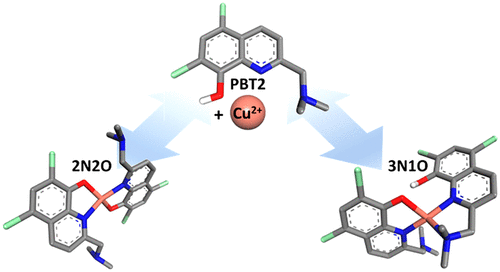当前位置:
X-MOL 学术
›
Inorg. Chem.
›
论文详情
Our official English website, www.x-mol.net, welcomes your
feedback! (Note: you will need to create a separate account there.)
Copper(II) Binding to PBT2 Differs from That of Other 8-Hydroxyquinoline Chelators: Implications for the Treatment of Neurodegenerative Protein Misfolding Diseases
Inorganic Chemistry ( IF 4.3 ) Pub Date : 2020-11-23 , DOI: 10.1021/acs.inorgchem.0c02754 Kelly L Summers 1, 2 , Graham P Roseman 3 , George J Sopasis 4 , Glenn L Millhauser 3 , Hugh H Harris 4 , Ingrid J Pickering 1, 2 , Graham N George 1, 2
Inorganic Chemistry ( IF 4.3 ) Pub Date : 2020-11-23 , DOI: 10.1021/acs.inorgchem.0c02754 Kelly L Summers 1, 2 , Graham P Roseman 3 , George J Sopasis 4 , Glenn L Millhauser 3 , Hugh H Harris 4 , Ingrid J Pickering 1, 2 , Graham N George 1, 2
Affiliation

|
PBT2 (5,7-dichloro-2-[(dimethylamino)methyl]-8-hydroxyquinoline) is a small Cu(II)-binding drug that has been investigated in the treatment of neurodegenerative diseases, namely, Alzheimer’s disease (AD). PBT2 is thought to be highly effective at crossing the blood–brain barrier and has been proposed to exert anti-Alzheimer’s effects through the modulation of metal ion concentrations in the brain, specifically the sequestration of Cu(II) from amyloid plaques. However, despite promising initial results in animal models and in clinical trials where PBT2 was shown to improve cognitive function, larger-scale clinical trials did not find PBT2 to have a significant effect on the amyloid plaque burden compared with controls. We propose that the results of these clinical trials likely point to a more complex mechanism of action for PBT2 other than simple Cu(II) sequestration. To this end, herein we have investigated the solution chemistry of Cu(II) coordination by PBT2 primarily using X-ray absorption spectroscopy (XAS), high-energy-resolution fluorescence-detected XAS, and electron paramagnetic resonance. We propose that a novel bis-PBT2 Cu(II) complex with asymmetric coordination may coexist in solution with a symmetric four-coordinate Cu(II)-bis-PBT2 complex distorted from coplanarity. Additionally, PBT2 is a more flexible ligand than other 8HQs because it can act as both a bidentate and a tridentate ligand as well as coordinate Cu(II) in both 1:1 and 2:1 PBT2/Cu(II) complexes.
中文翻译:

铜 (II) 与 PBT2 的结合不同于其他 8-羟基喹啉螯合剂:对治疗神经退行性蛋白质错误折叠疾病的影响
PBT2(5,7-二氯-2-[(二甲氨基)甲基]-8-羟基喹啉)是一种小型 Cu(II) 结合药物,已被研究用于治疗神经退行性疾病,即阿尔茨海默病 (AD)。 PBT2 被认为能够非常有效地穿过血脑屏障,并被认为可以通过调节大脑中的金属离子浓度,特别是从淀粉样斑块中螯合 Cu(II) 来发挥抗阿尔茨海默病的作用。然而,尽管在动物模型和临床试验中显示 PBT2 可以改善认知功能,初步结果令人鼓舞,但更大规模的临床试验并未发现与对照组相比,PBT2 对淀粉样斑块负荷有显着影响。我们认为,这些临床试验的结果可能表明 PBT2 的作用机制比简单的 Cu(II) 隔离更复杂。为此,我们主要使用 X 射线吸收光谱 (XAS)、高能分辨率荧光检测 XAS 和电子顺磁共振研究了 PBT2 配位 Cu(II) 的溶液化学。我们提出,具有不对称配位的新型双-PBT2 Cu(II)配合物可以与因共面性而扭曲的对称四配位Cu(II)-双-PBT2配合物共存于溶液中。此外,PBT2 是比其他 8HQ 更灵活的配体,因为它可以充当二齿和三齿配体,并在 1:1 和 2:1 PBT2/Cu(II) 配合物中配位 Cu(II)。
更新日期:2020-12-07
中文翻译:

铜 (II) 与 PBT2 的结合不同于其他 8-羟基喹啉螯合剂:对治疗神经退行性蛋白质错误折叠疾病的影响
PBT2(5,7-二氯-2-[(二甲氨基)甲基]-8-羟基喹啉)是一种小型 Cu(II) 结合药物,已被研究用于治疗神经退行性疾病,即阿尔茨海默病 (AD)。 PBT2 被认为能够非常有效地穿过血脑屏障,并被认为可以通过调节大脑中的金属离子浓度,特别是从淀粉样斑块中螯合 Cu(II) 来发挥抗阿尔茨海默病的作用。然而,尽管在动物模型和临床试验中显示 PBT2 可以改善认知功能,初步结果令人鼓舞,但更大规模的临床试验并未发现与对照组相比,PBT2 对淀粉样斑块负荷有显着影响。我们认为,这些临床试验的结果可能表明 PBT2 的作用机制比简单的 Cu(II) 隔离更复杂。为此,我们主要使用 X 射线吸收光谱 (XAS)、高能分辨率荧光检测 XAS 和电子顺磁共振研究了 PBT2 配位 Cu(II) 的溶液化学。我们提出,具有不对称配位的新型双-PBT2 Cu(II)配合物可以与因共面性而扭曲的对称四配位Cu(II)-双-PBT2配合物共存于溶液中。此外,PBT2 是比其他 8HQ 更灵活的配体,因为它可以充当二齿和三齿配体,并在 1:1 和 2:1 PBT2/Cu(II) 配合物中配位 Cu(II)。










































 京公网安备 11010802027423号
京公网安备 11010802027423号